WOLTS Tanzania Mundarara Community Facilitation Notes final (PDF)
File information
Title: Microsoft Word - WOLTS Tanzania Mundarara Community Facilitation Notes_final.docx
This PDF 1.3 document has been generated by Word / Mac OS X 10.11.6 Quartz PDFContext, and has been sent on pdf-archive.com on 07/03/2018 at 22:27, from IP address 86.4.x.x.
The current document download page has been viewed 441 times.
File size: 478.73 KB (15 pages).
Privacy: public file
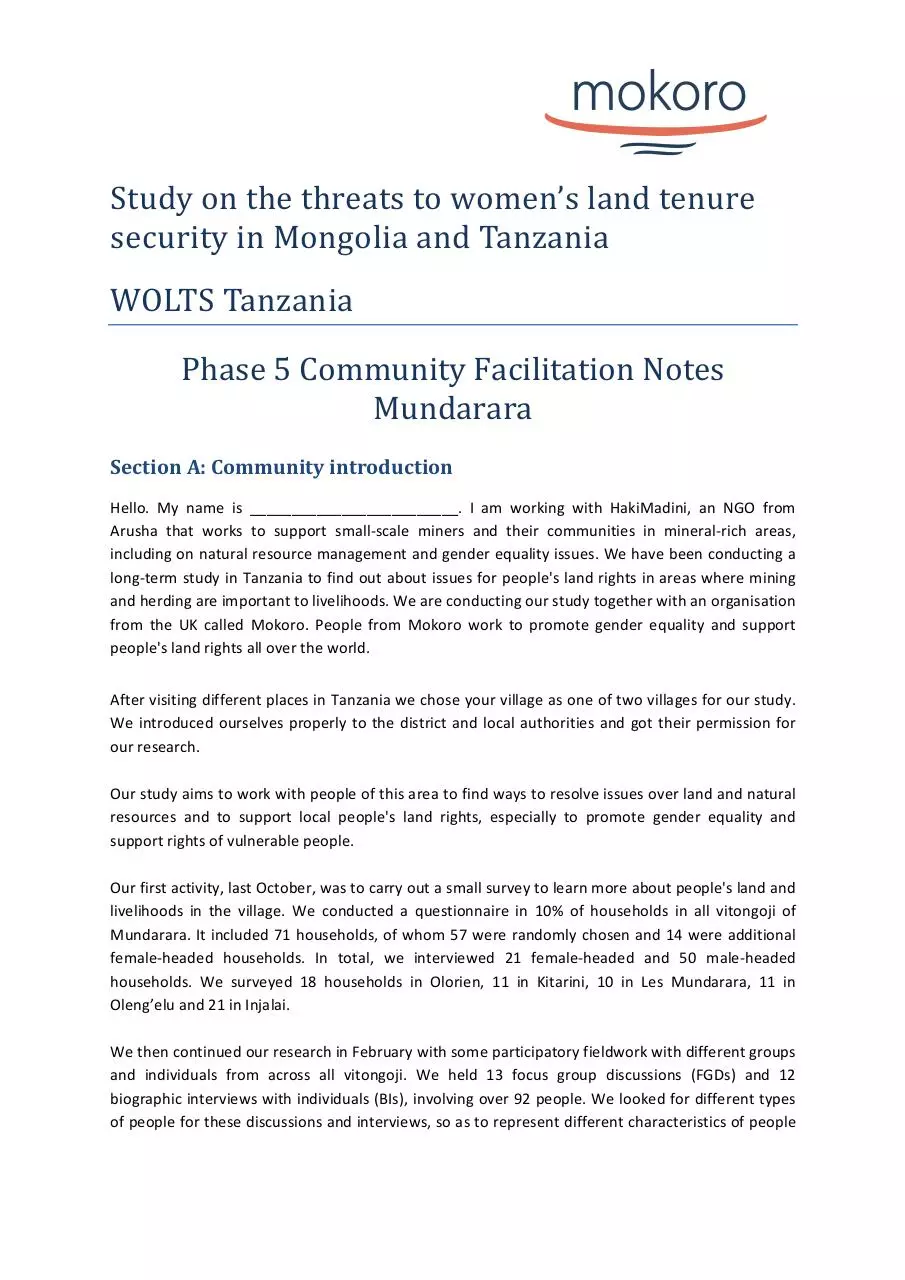
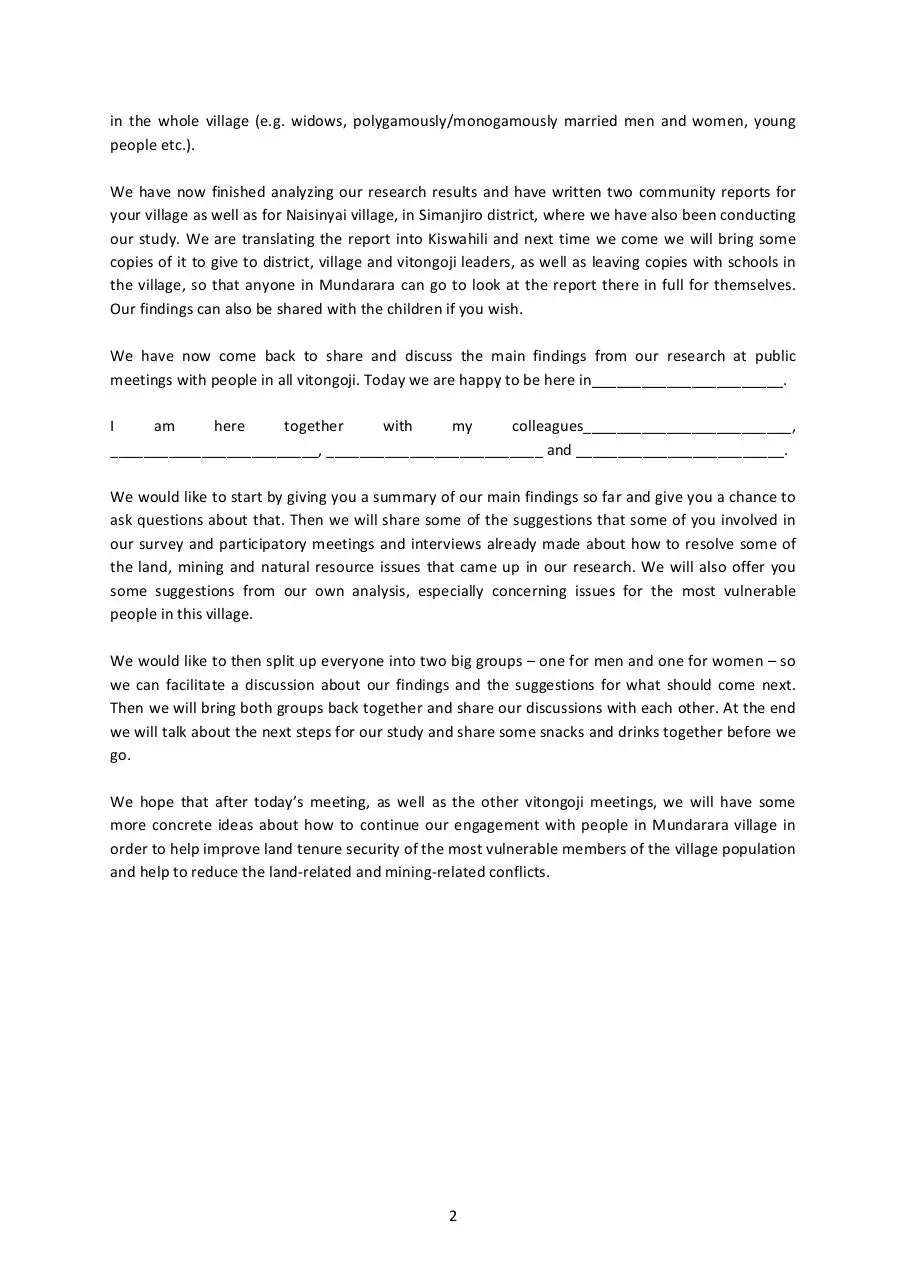
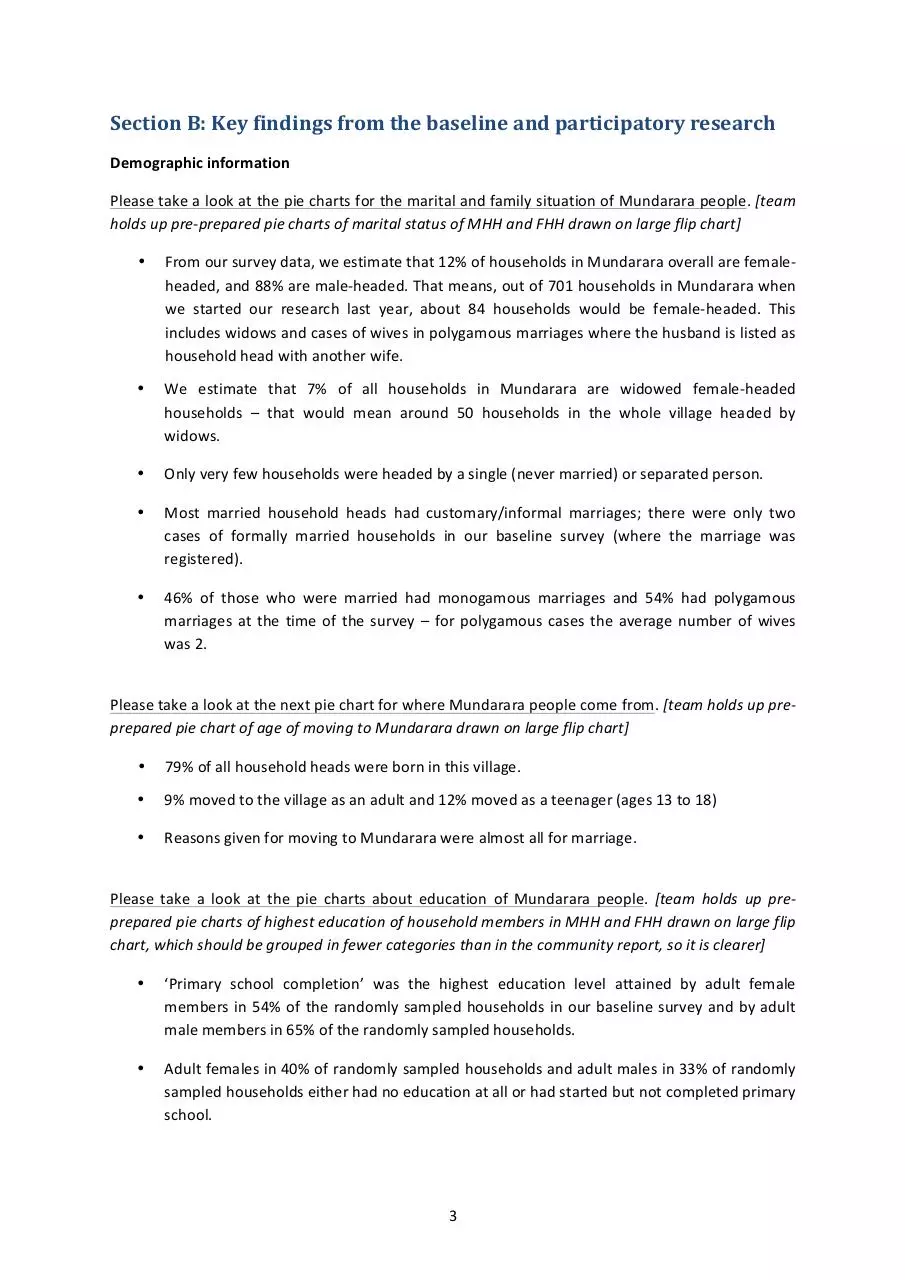
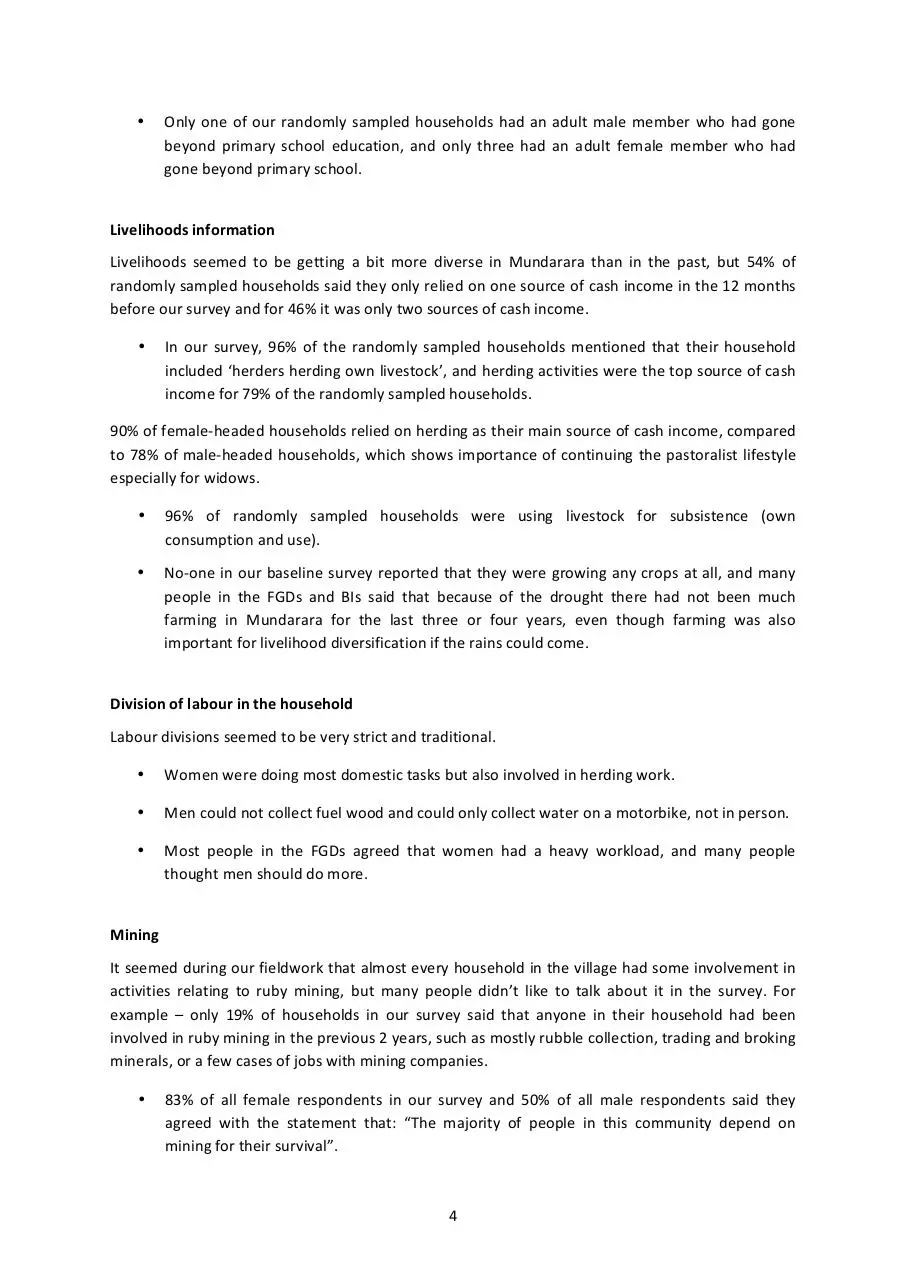
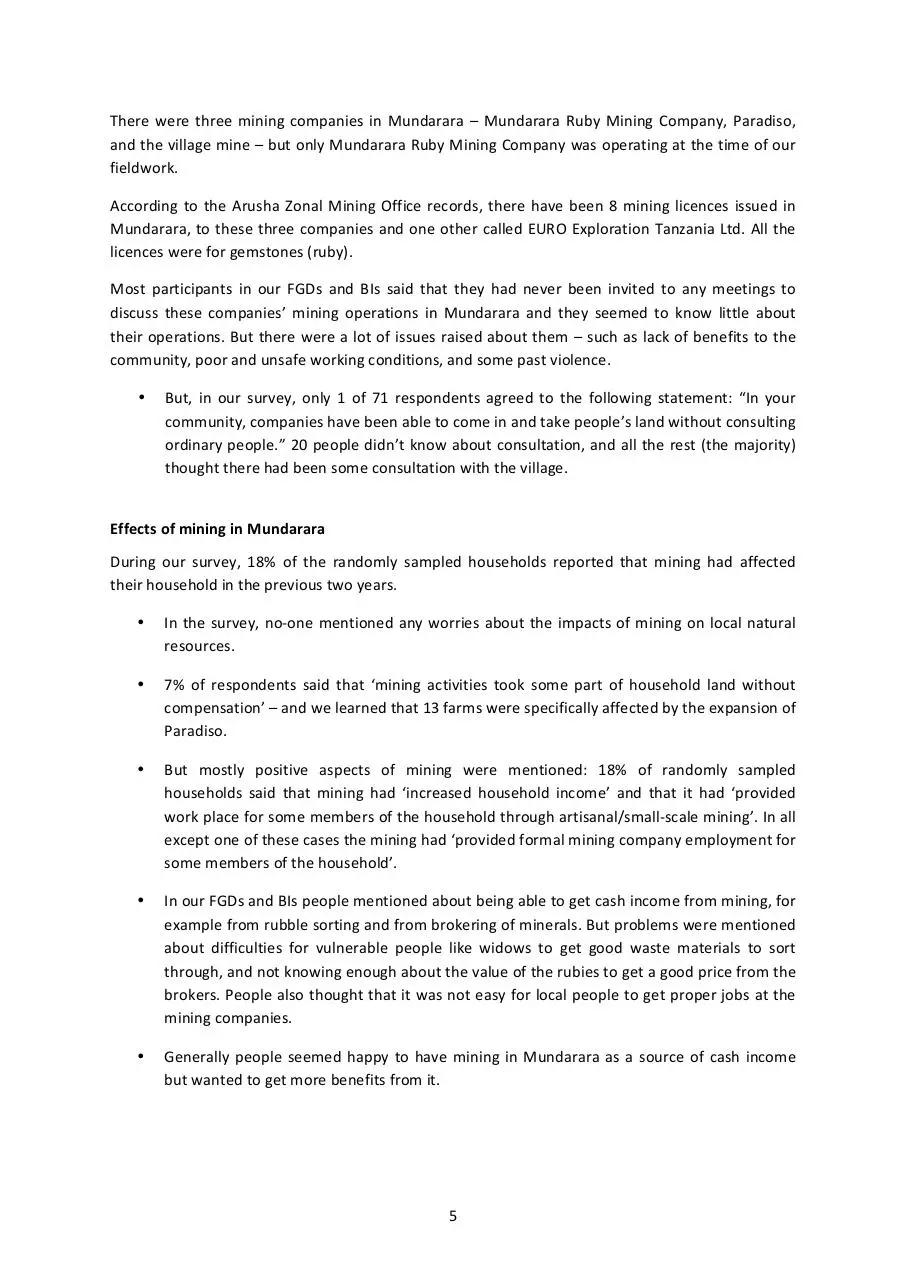
File preview
Study on the threats to women’s land tenure
security in Mongolia and Tanzania
WOLTS Tanzania
Phase 5 Community Facilitation Notes
Mundarara
Section A: Community introduction
Hello. My name is _________________________. I am working with HakiMadini, an NGO from
Arusha that works to support small-scale miners and their communities in mineral-rich areas,
including on natural resource management and gender equality issues. We have been conducting a
long-term study in Tanzania to find out about issues for people's land rights in areas where mining
and herding are important to livelihoods. We are conducting our study together with an organisation
from the UK called Mokoro. People from Mokoro work to promote gender equality and support
people's land rights all over the world.
After visiting different places in Tanzania we chose your village as one of two villages for our study.
We introduced ourselves properly to the district and local authorities and got their permission for
our research.
Our study aims to work with people of this area to find ways to resolve issues over land and natural
resources and to support local people's land rights, especially to promote gender equality and
support rights of vulnerable people.
Our first activity, last October, was to carry out a small survey to learn more about people's land and
livelihoods in the village. We conducted a questionnaire in 10% of households in all vitongoji of
Mundarara. It included 71 households, of whom 57 were randomly chosen and 14 were additional
female-headed households. In total, we interviewed 21 female-headed and 50 male-headed
households. We surveyed 18 households in Olorien, 11 in Kitarini, 10 in Les Mundarara, 11 in
Oleng’elu and 21 in Injalai.
We then continued our research in February with some participatory fieldwork with different groups
and individuals from across all vitongoji. We held 13 focus group discussions (FGDs) and 12
biographic interviews with individuals (BIs), involving over 92 people. We looked for different types
of people for these discussions and interviews, so as to represent different characteristics of people
in the whole village (e.g. widows, polygamously/monogamously married men and women, young
people etc.).
We have now finished analyzing our research results and have written two community reports for
your village as well as for Naisinyai village, in Simanjiro district, where we have also been conducting
our study. We are translating the report into Kiswahili and next time we come we will bring some
copies of it to give to district, village and vitongoji leaders, as well as leaving copies with schools in
the village, so that anyone in Mundarara can go to look at the report there in full for themselves.
Our findings can also be shared with the children if you wish.
We have now come back to share and discuss the main findings from our research at public
meetings with people in all vitongoji. Today we are happy to be here in_______________________.
I
am
here
together
with
my
colleagues_________________________,
_________________________, __________________________ and _________________________.
We would like to start by giving you a summary of our main findings so far and give you a chance to
ask questions about that. Then we will share some of the suggestions that some of you involved in
our survey and participatory meetings and interviews already made about how to resolve some of
the land, mining and natural resource issues that came up in our research. We will also offer you
some suggestions from our own analysis, especially concerning issues for the most vulnerable
people in this village.
We would like to then split up everyone into two big groups – one for men and one for women – so
we can facilitate a discussion about our findings and the suggestions for what should come next.
Then we will bring both groups back together and share our discussions with each other. At the end
we will talk about the next steps for our study and share some snacks and drinks together before we
go.
We hope that after today’s meeting, as well as the other vitongoji meetings, we will have some
more concrete ideas about how to continue our engagement with people in Mundarara village in
order to help improve land tenure security of the most vulnerable members of the village population
and help to reduce the land-related and mining-related conflicts.
2
Section B: Key findings from the baseline and participatory research
Demographic information
Please take a look at the pie charts for the marital and family situation of Mundarara people. [team
holds up pre-prepared pie charts of marital status of MHH and FHH drawn on large flip chart]
•
From our survey data, we estimate that 12% of households in Mundarara overall are femaleheaded, and 88% are male-headed. That means, out of 701 households in Mundarara when
we started our research last year, about 84 households would be female-headed. This
includes widows and cases of wives in polygamous marriages where the husband is listed as
household head with another wife.
•
We estimate that 7% of all households in Mundarara are widowed female-headed
households – that would mean around 50 households in the whole village headed by
widows.
•
Only very few households were headed by a single (never married) or separated person.
•
Most married household heads had customary/informal marriages; there were only two
cases of formally married households in our baseline survey (where the marriage was
registered).
•
46% of those who were married had monogamous marriages and 54% had polygamous
marriages at the time of the survey – for polygamous cases the average number of wives
was 2.
Please take a look at the next pie chart for where Mundarara people come from. [team holds up preprepared pie chart of age of moving to Mundarara drawn on large flip chart]
•
79% of all household heads were born in this village.
•
9% moved to the village as an adult and 12% moved as a teenager (ages 13 to 18)
•
Reasons given for moving to Mundarara were almost all for marriage.
Please take a look at the pie charts about education of Mundarara people. [team holds up preprepared pie charts of highest education of household members in MHH and FHH drawn on large flip
chart, which should be grouped in fewer categories than in the community report, so it is clearer]
•
‘Primary school completion’ was the highest education level attained by adult female
members in 54% of the randomly sampled households in our baseline survey and by adult
male members in 65% of the randomly sampled households.
•
Adult females in 40% of randomly sampled households and adult males in 33% of randomly
sampled households either had no education at all or had started but not completed primary
school.
3
•
Only one of our randomly sampled households had an adult male member who had gone
beyond primary school education, and only three had an adult female member who had
gone beyond primary school.
Livelihoods information
Livelihoods seemed to be getting a bit more diverse in Mundarara than in the past, but 54% of
randomly sampled households said they only relied on one source of cash income in the 12 months
before our survey and for 46% it was only two sources of cash income.
•
In our survey, 96% of the randomly sampled households mentioned that their household
included ‘herders herding own livestock’, and herding activities were the top source of cash
income for 79% of the randomly sampled households.
90% of female-headed households relied on herding as their main source of cash income, compared
to 78% of male-headed households, which shows importance of continuing the pastoralist lifestyle
especially for widows.
•
96% of randomly sampled households were using livestock for subsistence (own
consumption and use).
•
No-one in our baseline survey reported that they were growing any crops at all, and many
people in the FGDs and BIs said that because of the drought there had not been much
farming in Mundarara for the last three or four years, even though farming was also
important for livelihood diversification if the rains could come.
Division of labour in the household
Labour divisions seemed to be very strict and traditional.
•
Women were doing most domestic tasks but also involved in herding work.
•
Men could not collect fuel wood and could only collect water on a motorbike, not in person.
•
Most people in the FGDs agreed that women had a heavy workload, and many people
thought men should do more.
Mining
It seemed during our fieldwork that almost every household in the village had some involvement in
activities relating to ruby mining, but many people didn’t like to talk about it in the survey. For
example – only 19% of households in our survey said that anyone in their household had been
involved in ruby mining in the previous 2 years, such as mostly rubble collection, trading and broking
minerals, or a few cases of jobs with mining companies.
•
83% of all female respondents in our survey and 50% of all male respondents said they
agreed with the statement that: “The majority of people in this community depend on
mining for their survival”.
4
There were three mining companies in Mundarara – Mundarara Ruby Mining Company, Paradiso,
and the village mine – but only Mundarara Ruby Mining Company was operating at the time of our
fieldwork.
According to the Arusha Zonal Mining Office records, there have been 8 mining licences issued in
Mundarara, to these three companies and one other called EURO Exploration Tanzania Ltd. All the
licences were for gemstones (ruby).
Most participants in our FGDs and BIs said that they had never been invited to any meetings to
discuss these companies’ mining operations in Mundarara and they seemed to know little about
their operations. But there were a lot of issues raised about them – such as lack of benefits to the
community, poor and unsafe working conditions, and some past violence.
•
But, in our survey, only 1 of 71 respondents agreed to the following statement: “In your
community, companies have been able to come in and take people’s land without consulting
ordinary people.” 20 people didn’t know about consultation, and all the rest (the majority)
thought there had been some consultation with the village.
Effects of mining in Mundarara
During our survey, 18% of the randomly sampled households reported that mining had affected
their household in the previous two years.
•
In the survey, no-one mentioned any worries about the impacts of mining on local natural
resources.
•
7% of respondents said that ‘mining activities took some part of household land without
compensation’ – and we learned that 13 farms were specifically affected by the expansion of
Paradiso.
•
But mostly positive aspects of mining were mentioned: 18% of randomly sampled
households said that mining had ‘increased household income’ and that it had ‘provided
work place for some members of the household through artisanal/small-scale mining’. In all
except one of these cases the mining had ‘provided formal mining company employment for
some members of the household’.
•
In our FGDs and BIs people mentioned about being able to get cash income from mining, for
example from rubble sorting and from brokering of minerals. But problems were mentioned
about difficulties for vulnerable people like widows to get good waste materials to sort
through, and not knowing enough about the value of the rubies to get a good price from the
brokers. People also thought that it was not easy for local people to get proper jobs at the
mining companies.
•
Generally people seemed happy to have mining in Mundarara as a source of cash income
but wanted to get more benefits from it.
5
Environmental issues
The overall picture to emerge from our fieldwork in Mundarara was one of increasing land scarcity,
population growth and environmental issues from the recent prolonged drought but also from
longer-term climate change pressures.
•
We heard reports of conflicts over grazing areas, and we learned that people were having to
migrate their livestock further from the village than in the past because of the
environmental/climate issues.
National parks
During our survey, 39% of the randomly sampled households reported that national parks had
affected their household in the previous two years – so more than twice as many who reported
being affected by mining.
•
The vast majority of these households were living in Injalai and Olorien – equivalent to 53%
of households in Injalai and 64% of those in Olorien.
•
37% of all randomly sampled households reported that national parks had ‘reduced
household income’, but there was one case where the national parks were reported to have
‘provided informal work for some members of the household’.
•
12% of all randomly sampled households reported that protected areas ‘restricted access to
communal grazing land’.
About decision-making and involvement of everyone in land management
Only 25% of all male respondents in our survey and 51% of all female respondents thought that
women played a big role in decision-making about natural resources in Mundarara.
67% of all male respondents and 63% of all female respondents thought that all people were
involved and consulted in decisions about community land management.
We also learned that Mundarara has a Village Land Use Plan to help regulate land management.
Access to land
96% of the randomly sampled households in our survey reported that household members owned
the household’s main housing plot in Mundarara, i.e. the place where the majority of household
members usually lived; no-one seemed to be renting or borrowing a house in the survey.
Most people seemed to know the process for applying to the village government for housing or
farmland. Some people considered the fees to be too high for them and this was big problem for
poorer people.
6
•
It was also very hard for women to apply for land without the support of a man (husband,
brother or adult son), and this was a particular problem for female-headed households such
as widows.
In total some 68% of the randomly sampled households in our survey reported that they had land
for non-residential purposes – in 13% of these cases it was in a different (neighbouring) village, in
82% of them it was in the kitongoji they lived in in Mundarara (and 5% of cases did not answer).
Some of this was for farming and some was grazing land that they had acquired for their own use.
•
Generally people considered that the family jointly owned the house plot, but very few
people had any kind of documents for their land.
Please take a look at the next pie chart about ways of getting non-residential land in Mundarara.
[team holds up pre-prepared pie chart of types of ways of getting land drawn on large flip chart]
•
31% of randomly sampled households had inherited their land; 63% had got their land from
the village government. 3% had bought land and 3% had just taken land and built on it.
•
Only a quarter of randomly sampled households reported thinking that land disputes were a
big issue in Mundarara.
•
There were also not many disputes reported in our survey about land, and the only ones we
heard about concerned land boundaries. People were more concerned about access to land,
especially for poor people.
Please take a look at the next pie charts about grazing land in Mundarara. [team holds up preprepared pie charts of grazing patterns in MHH and FHH drawn on large flip chart]
•
2% of all male-headed households in our survey didn’t have any livestock at all and nor did
5% of all the female-headed households. A further 5% of all female-headed households
didn’t have any livestock that needed grazing, they just grazed at the boma.
•
88% of all male-headed households reported to be giving some of their livestock to other
people to graze, compared to 71% of all female-headed households – as the main method of
grazing.
•
94% of all female respondents and 100% of all male respondents in our survey agreed with
the statement that: “The majority of people in this community depend on herding livestock
for their survival”
•
32% of female respondents and 63% of male respondents were concerned about access to
grazing areas.
•
59% of all female respondents and 63% of all male respondents were concerned about
access to water.
7
•
Migration patterns have also changed – it seemed nowadays that only some of the family
migrated with livestock while others stayed at the boma. This seemed to be partly to protect
the boma area as people saw land as having more value now, and also there were fewer
areas left that could be allocated for new settlements or farms because of population
pressures and the demarcations of the Land Use Plans.
Understanding of the law
Most people did not seem to have a good understanding of the relevant Tanzanian laws. For
example:
•
44% of all female respondents and 50% of all male respondents in our survey correctly knew
that women were allowed to own land.
•
48% of all female respondents and 50% of all male respondents correctly knew that
discrimination between men and women as regards land ownership was illegal.
•
And, 49% of all female respondents and 75% of all male respondents thought that according
to Tanzania law men’s rights to land take precedence over women’s rights, which is not
correct.
Furthermore, 52% of all female respondents and 25% of all male respondents believed, incorrectly,
that having rights to the land also meant having the rights to the minerals under the land; while
many did not know whether that was the case or not.
Summary of Conclusions
Climate change and population growth have both contributed to making pastoralist livelihoods in
Mundarara less predictable than they used to be.
Ø The uptake of farming activities (despite the drought of the last few years) has coincided
with land tenure becoming more formalised and land management more regulated.
Ø The establishment of a Land Use Plan has demarcated the areas set aside for pasture, and
thereby reduced the availability of land for the expansion of housing and farming.
As a result, many people have started trying to diversify their livelihoods, and mining has provided
one avenue for diversification – even though expansion of the mining sites has also contributed to
pressures on overall land availability in the village.
While some employment has been created by the mining companies, the main beneficiaries from
mining appear to be the many male traders and brokers, some of whom have become relatively
wealthy from selling rubies.
Ø Mining has also provided women (and especially widows) with some opportunities to
generate a small cash income through the collection and sale of left-over rubble.
8
Ø However, the benefits to women have been minimised due to their lack of knowledge about
the value of the minerals they are collecting, as well as the gender-specific discrimination
they face in accessing the rubble, which ranged from verbal abuse to direct violence in the
accounts we heard in our research.
Even though mining and related activities have clearly contributed to the local economy in
Mundarara, there have also been some negative issues raised.
Ø We learned that many local people were unhappy about the limited engagement of the
mining companies with the local community, and that improvements were needed in terms
of consultation, compensation and the provision of more benefits from mining to the
community.
Ø These issues have contributed to resentment building up and have led to some violence and
protests.
The increased involvement of local men in mining, as well as the general trend towards livelihood
diversification, have led local women to take on more roles outside the household.
Ø While women were increasingly engaged in herding, and many also engaged in various cash
income-earning activities, women still continued to be responsible for all domestic work and
were often not allowed to keep any money they made from their small businesses.
We found that decision-making within the community remained largely male-dominated at all levels,
despite the involvement of women in formal government institutions as required by law.
Ø However, changes seemed to be visible within at least some households.
Ø For example, although polygamy was still more common than monogamy, monogamous
marriages appeared to be becoming more common and were characterised by more equity
of household decision-making, for example about household budgeting and expenditure.
Ø Even in polygamous households, it appeared that some women may have held more power
than was openly acknowledged, and it was often mentioned that the favoured wives were
more involved in decision-making and had more rights than other wives.
Ø It also seemed that what people said they did, and what they actually did, was not always
the same, and some men seemed very open to changes that would support women’s rights
and benefit everyone in the household while also being respectful of culture and traditions.
The increasing formalisation of land tenure in theory has provided women in Mundarara with equal
rights to access land and to have formal joint ownership of household land, thereby ensuring their
tenure security.
9
Download WOLTS Tanzania Mundarara Community Facilitation Notes final
WOLTS Tanzania Mundarara Community Facilitation Notes_final.pdf (PDF, 478.73 KB)
Download PDF
Share this file on social networks
Link to this page
Permanent link
Use the permanent link to the download page to share your document on Facebook, Twitter, LinkedIn, or directly with a contact by e-Mail, Messenger, Whatsapp, Line..
Short link
Use the short link to share your document on Twitter or by text message (SMS)
HTML Code
Copy the following HTML code to share your document on a Website or Blog
QR Code to this page

This file has been shared publicly by a user of PDF Archive.
Document ID: 0000742472.